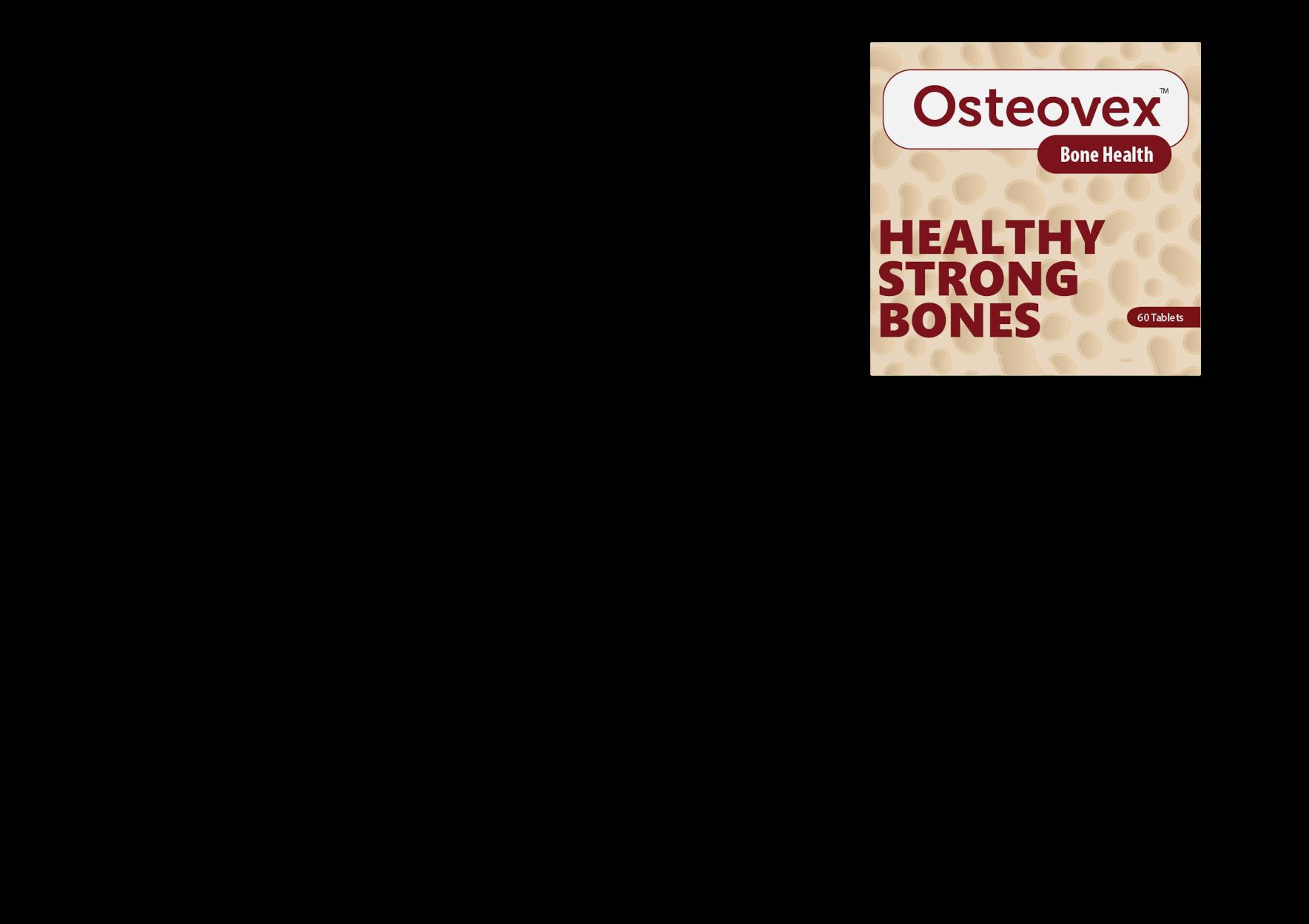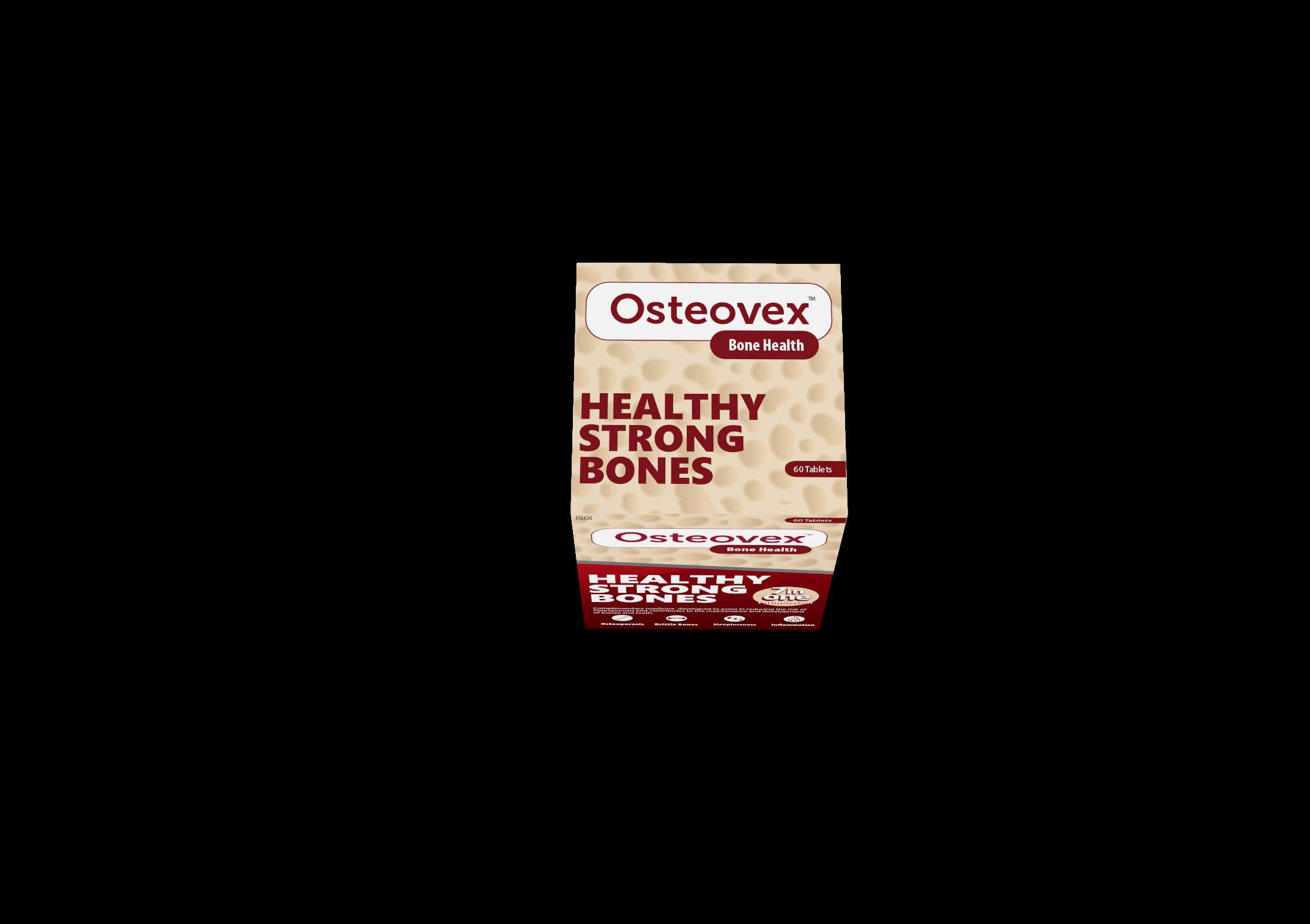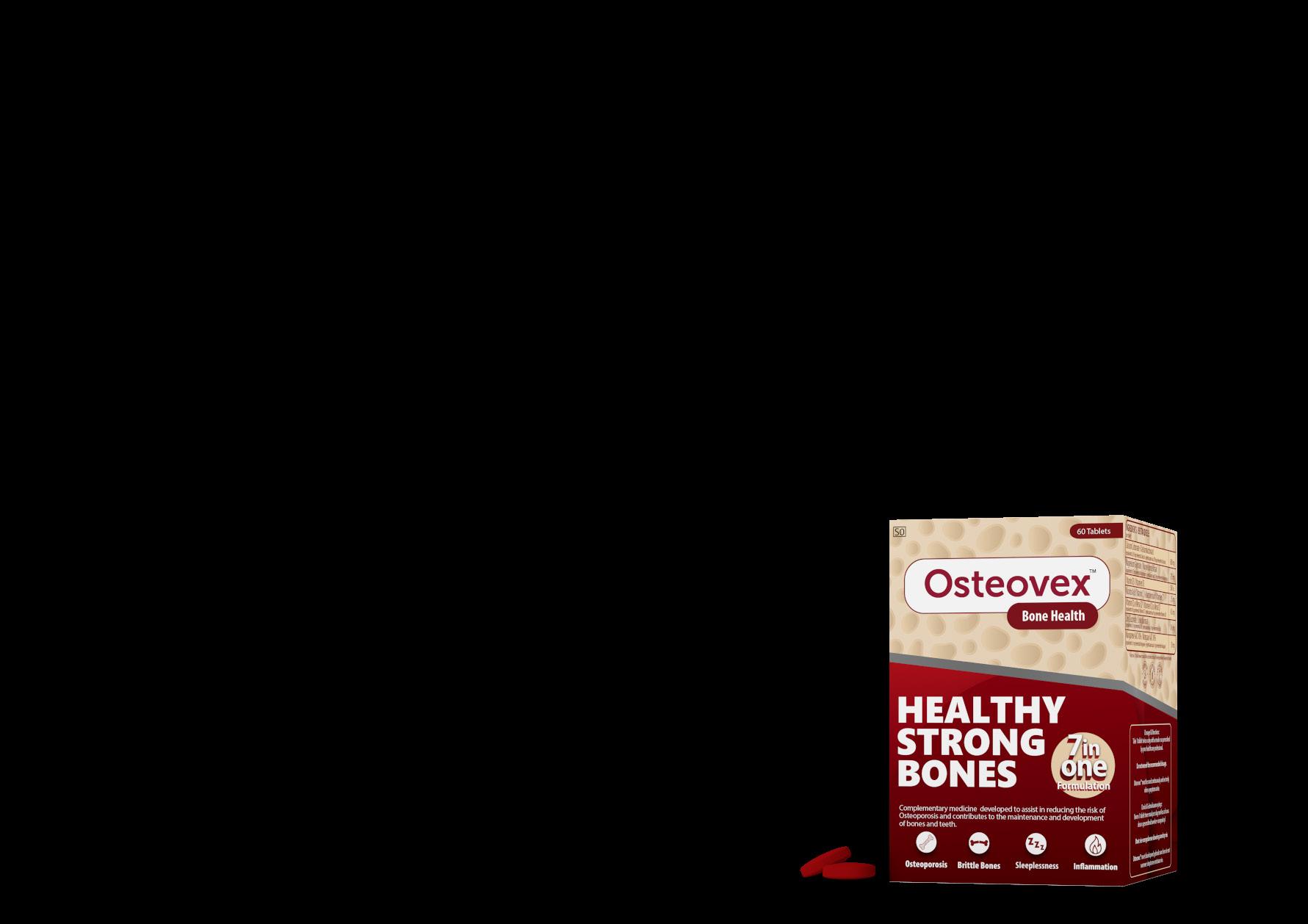Information Catalog












Osteovex™ was developed to assist in the treatment of Osteoporosis and acts as a prophylactic for early onset osteoporosis by combining a blend of well documented ingredients which have shown to
• Promote bone density
• Maintain healthy bone function and density
• Reduce lower grade inflammation
• Reduce the risk of hairline fractures caused by minor injuries
Osteoporosis is known as a metabolic bone disease that has shown to have low bone mass and deterioration of bone tissue that leads to enhanced bone fragility and increase risk of fractures (Lanham, 2008). Peak bone mass is an important factor in determining bone mass and fracture risk later in life- attaining a high peak bone mass is a good preventative strategy for fracture reduction (Lanham, 2008). Osteoporosis is seen to be most prevalent in the elderly and in postmenopausal women.
Osteoporosis and related fractures are a major cause of morbidity and disability in the elderly that leads to premature death (Pepa & Brandi, 2016). Bone is an active tissue physiologically and is constantly remodeled by interactions between osteoclasts (Involved in bone resorption) and osteoblasts (Bone formation and mineralization) (Pepa & Brandi, 2016). For this to be successful, an adequate supply of macronutrients and micronutrients such as vitamins and minerals are needed (Pepa & Brandi, 2016).
(Each tablet contains)

Throughout research, it is prevalent that osteoporosis is a concern within the elderly community and specifically post-menopausal women. After menopause the process of osteoporosis is accelerated due to the deficiency of estrogen- estrogen helps with positive calcium metabolism and osteogenesis (Thulkar & Singh, 2015).In a study where 23 postmenopausal women were assessed on the dietary intake of nutrients such as magnesium, zinc and calcium, results showed that it was significantly low- this can be an indication that supplements will be beneficial in not only increasing intake but help in bone density (Mahdavi-Roshan, Ebrahimi, & Ebrahimi, 2015).
Take 1 tablet in the morning and 1 tablet in the late afternoon with a meal and 300ml water.
Per tablet Per Day
Calcium Carbonate (equivalent to 250mg elemental Calcium) 600 mg 1200 mg
Magnesium Glycinate (equivalent to 35mg elemental magnesium) 175 mg 350 mg
Vitamin D3 500 iu 1000 iu
Ascorbic Acid (Vitamin C) 25 mg 50 mg
Vitamin K2 as MenaQ7 0.045 mg 0.090 mg
Zinc gluconate (equivalent to 1mg elemental zinc) 8.4 mg 16.8 mg


Manganese AAC 10% (equivalent to 1mg elemental Manganese) 10 mg 20 mg

Calcium is the most abundant mineral in the human body with about 99 percent of Calcium located within the bones and teeth (Lanham, 2008). Calcium supports structural integrity and regulates metabolic function (Lanham, 2008). The remaining 1 percent is needed for many activities that help keep the body functioning normally. Calcium also helps blood vessels contract and expand, makes muscles contract, helps send messages through the nervous system and helps glands secrete hormones (Lanham, 2008).
Bones are constantly remodelled every day, and calcium moves in and out of them. In children and adolescents, the body builds new bone faster than it breaks down old bone so total bone mass increases. This continues until about age 30, when new bone formation and old bone breakdown start occurring at about the same rate. In older adults, especially in post-menopausal women, bone is broken down at a faster rate than it is built. If calcium intake is too low, this can contribute to osteoporosis (National Institutes of Health, 2022).

Calcium carbonate provides 40 percent elemental calcium; the other 60 percent is the carbonate ingredient. Therefore, 600 milligrams (mg) of calcium carbonate provides 240 mg elemental calcium. Calcium citrate is 20 percent elemental calcium; 600 mg of calcium citrate provides 120 mg elemental calcium. The most common calcium used in Calcium supplements is calcium citrate (National Institutes of Health, 2022). Osteovex™ contains Calcium Carbonate which is the calcium form which contains the highest value of elemental calcium.
Within a study where over 3000 elderly women were either given a placebo or a dose of 1200mg Calcium and 800iu of Vitamin D; the group that took calcium and Vitamin D every day showed a 30 percent decrease in risk of hip and other fractures (Heaney, 2002). Of the group that did not take supplementation, a 3 percent decrease in bone mass as hip site were observed per year whereas the supplementation group showed a bone mass gain (Heaney, 2002).
The active absorption of Calcium is highly dependent on vitamin D, and vitamin D deficiency decreases the absorption of Calcium (Al Omari, Rashid, Qinna, Jaber, & Badwan, 2016). Mueller et al. showed that daily intake of 1200 mg of Calcium, as calcium carbonate, and 800 IU of vitamin D3, increased the intestinal Calcium absorption compared to the results from the placebo study (Al Omari, Rashid, Qinna, Jaber, & Badwan, 2016).
Magnesium is a mineral naturally found in foods like whole-grain breads, dark green vegetables, and nuts. Magnesium and calcium work together closely to maintain strong bones. About 60 percent of Magnesium is stored in the bone and Magnesium is an essential part to all living cells, including osteoblasts and osteoclasts (Castiglioni, Cazzaniga, Albisetti, & Maier, 2013).
Magnesium deficiency contributes to osteoporosis directly by acting on crystal formation and on bone cells also indirectly by impacting on the secretion and the activity of parathyroid hormone and by promoting low grade inflammation (Castiglioni, Cazzaniga, Albisetti, & Maier, 2013). Magnesium restriction also increases oxidative stress due to the inflammation and reduced antioxidant defences, this causes the quantity of free radicals to increase and potentiate the activity of the osteoclasts and depresses that of osteoblasts (Castiglioni, Cazzaniga, Albisetti, & Maier, 2013).
Studies have indicated that there is a correlation between Magnesium deficiency and osteoporosis- specifically so in post-menopausal women and their bone density (Castiglioni, Cazzaniga, Albisetti, & Maier, 2013).

New research – conducted by scientists from the University of Bristol in the United Kingdom and the University of Eastern Finland in Kuopio – suggests that low levels of magnesium may increase the risk of bone fractures and that, conversely, high levels may ward off this cause of disability (Kunutsor, Whitehouse, Blom, & Laukkanen, 2017). The study was based on a large population sample of 2,245 middle-aged men, who were clinically followed for 20 years. During this time, the researchers found that participants with low levels of serum magnesium had a significantly higher risk of bone fractures. The association was stronger for hip fractures. Men with higher levels of magnesium were 44 percent less likely to have bone fractures. Additionally, over the 20-year follow-up period, none of the 22 men who had very high levels of magnesium had a bone fracture (Kunutsor, Whitehouse, Blom, & Laukkanen, 2017).

Magnesium Biglycinate is a preferred from of Magnesium because it is well tolerated and absorbed in the body. Magnesium is combined with an amino acid known as glycine and glycine works alongside many neurotransmitters (chemicals in your brain), like GABA, to promote feelings of calm (Greenblatt, 2016). Glycine may also improve sleep quality and promote a healthy circadian rhythm as well as assist in inflammation (Lamontagne, Sewell, Vaillancourt, & Kuhzarani, 2012).
Within a study where a 100-year-old male was administered Magnesium Glycinate orally and topically every day (after many other regimens) for chronic back pain like that of osteoporosis, results indicated that he experienced reduction in pain, increased flexibility and improved quality of life (Lamontagne, Sewell, Vaillancourt, & Kuhzarani, 2012).
Known as the sunshine vitamin, vitamin D is produced by the body in response to skin being exposed to sunlight. It occurs naturally in a few foods — including some fish, fish liver oils, and egg yolks — and in fortified dairy and grain products.
The capacity of older individuals to produce vitamin D drops significantly as time goes by. Studies show that the capacity for older individuals to endogenously produce Vitamin D is equal to 25% of the capacity of younger individuals (between 20-30) who have spent the same amount of time in sunlight (Hill & Aspray, 2017). Although the exact reason for this is not exactly understood, the most logical explanation is that older people spend less time in the sun (often due to less physical activity), use more sunscreen and wear less revealing clothing (Hill & Aspray, 2017).
Vitamin D is essential for absorption of Calcium (Al Omari, Rashid, Qinna, Jaber, & Badwan, 2016). Calcium is absorbed from the bowel by an active vitamin D-dependent transport mechanism and by passive diffusion (Hill & Aspray, 2017). The active transport mechanism plays an important role in calcium homeostasis, as calcium absorbed is inversely related to dietary intake (Hill & Aspray, 2017). Although the decline in calcium absorption with advancing age is probably multifactorial in origin, the effects of vitamin D supplementation suggest that vitamin D deficiency is the major cause of malabsorption of calcium in older people (Heaney, 2002).

As mentioned, many studies show that the intake of vitamin D3 with Calcium can significantly reduce osteoporotic fracture risk and in some cases slightly increase bone mass (Heaney, 2002). Studies show that when taking Vitamin D with calcium, a decrease in bone mass is shown (Heaney, 2002). Furthermore, this combination is essential as the active absorption of calcium is highly dependent on Vitamin D (Al Omari, Rashid, Qinna, Jaber, & Badwan, 2016).

Like any vitamin or mineral, vitamin D can’t work without first being converted into a form your body can absorb. The level to which a vitamin or mineral can be absorbed is known as its “bioavailability”. Vitamin D’s bioavailability depends on magnesium. The enzymes in the liver and kidneys) that enable vitamin D metabolism—converting it into its active form, calcitriol—can’t work without enough magnesium to draw upon. Unconverted, vitamin D can increase your calcium levels rather than regulate them as they should. And exceeding your recommended dietary allowance of calcium can stimulate your hormones into drawing the mineral out of your bones—where it’s needed—and depositing it in soft tissues such as arteries (Ross, Taylor, & Yaktine, 2011).
Both Vitamin D and Magnesium is needed in sufficient amounts for maintaining physiological functions of various organs and in turn help regulate calcium and phosphate balance for the maintenance of healthy bone functions (Uwitonze & Razzaque, 2018).
www.osteovex.co.za
Vitamin C is widely known as a powerful antioxidant as well as an effective cell protector and immunity booster. But supplements of vitamin C have recently been recognized as having an important role in the prevention and treatment of osteoporosis because of its ability to increase bone density (Aghajanian, Hall, Wongworawat, & Mohan, 2015).
Research suggests that Vitamin C has a positive effect on bone formation by stimulating the protein collagen in the bone, and that it also leads to increased bone mineral density. The vitamin is also used for growth and repair of tissues, including tendons, ligaments, and blood vessels, and it aids in the absorption of iron (Aghajanian, Hall, Wongworawat, & Mohan, 2015).
Within as study where older individuals were given a vitamin c supplementation, results indicated that the risk for hip fractures were significantly reduced in subjects taking vitamin c compared to those that was not supplemented (Aghajanian, Hall, Wongworawat, & Mohan, 2015).
Overall, studies suggested that vertebrate organisms that has a vitamin C deficiency has an increased risk of developing bone disorders such as spontaneous fracturing, impaired bone growth and impaired bone healing (Aghajanian, Hall, Wongworawat, & Mohan, 2015).

Vitamin K2 is a fat-soluble vitamin and one of its isoforms is vitamin K2 which has chemical variants such as MK-7 and is transported by lipoproteins from the liver to tissues such as the bone (Myneni & Mezey, 2017).
Vitamin K2 has been researched and found to regulate bone remodelling, which is an essential factor in maintaining adult bone (Myneni & Mezey, 2017). Bone remodelling refers to the process of removing old or damaged bone by osteoclasts and replacing it by new bone formed by osteoblasts in the body (Myneni & Mezey, 2017). When there is an imbalance between bone resorption and bone formation, development of osteoporosis is a reality (Myneni & Mezey, 2017).
Osteoblasts produce a protein called Osteocalcin, a vitamin K-dependent protein that binds calcium to the bone matrix and builds healthy bones. But Osteocalcin needs adequate Vitamin K2 to activate it (Myneni & Mezey, 2017).

In a study where 244 healthy postmenopausal women received either a placebo or Vitamin K2 (MK-7) everyday for 3 years, the results indicated that the group that got the K2 showed increase bone strength and decrease risk of fracture (Knapen, Drummen, Smit, Vermeer, & Theuwissen, 2013). Therefore, indicating that Vitamin K2 as Menaq7 can help postmenopausal women to prevent bone loss.
Vitamin K2 has also been shown to decrease the risk for heart disease (Rotterdam Study) which ensures healthy arterial tissues (NattoPharma, 2022).
MenaQ7® is the only clinically validated, patented Vitamin K2 as MK-7 available on the market today and it meets the demands of an increasingly growing global market for health solution products, MenaQ7® varieties are suitable for vegans and vegetarians, free from gluten, dairy, soy, and other known allergens (NattoPharma, 2022).

Zinc is known to be an essential nutritional element in the growth of the human and animals and bone growth retardation has been one of the findings in various conditions associated with dietary zinc deficiency. The zinc content in bone has been shown to decrease in aging, skeletal unloading, and postmenopausal conditions, suggesting it might have a part to play in bone disorders such as osteoporosis. Zinc has also been researched to have a stimulatory effect on osteoblastic bone formation and mineralization (Yamaguchi, 2010).
Zinc has been shown to inhibit osteoclast bone resorption and suppressing osteoclast-like cell formation as well as stimulate gene expression in osteoblastic cells (Pepa & Brandi, 2016).

Zinc stimulates bone growth by activating enzymes (An enzyme is a protein that triggers chemical reactions in your body therefore enzymes help regulate biological processes, like bone-building) (Algaecal, 2022). The enzyme that requires zinc is called alkaline phosphatase that relates to the function of osteoblasts of bone cells (Yamaguchi & Yamagushi, 1986). Bone-specific Alkaline phosphatase plays a role in bone mineralization and is often used as a marker of bone formation (Algaecal, 2022). In a study where oral medication was given to subjects, the results indicated that there was an increase in alkaline phosphatase activity and DNA content in the bone cells suggesting bone formation and the significance of Zinc in the regulating of bone growth (Yamaguchi & Yamagushi, 1986).
Manganese is an element that is distributed in tissues throughout the body, including bone; manganese activates phosphatases, kinases, decarboxylases and glycosyltransferases (Pepa & Brandi, 2016). Research has shown manganese play as a co-factor in the formation of bone cartilage and bone collagen, as well as in bone mineralization (Pepa & Brandi, 2016).


Aghajanian, P., Hall, S., Wongworawat, M., & Mohan, S. (2015). The Roles and Mechanisms of Actions of Vitamin C in Bone: New Developments. Journal of Bone and Mineral Research, 30(11), 1945-1955.
Al Omari, M., Rashid, I., Qinna, N., Jaber, A., & Badwan, A. (2016). Calcium Carbonate. Profiles of Drug Substances, Excipients, and related methodology, 41, 31-112.
Algaecal. (2022, November 6). Zinc Health Benefits and the Best Dietary Sources. Retrieved from Algaecal: https://www.algaecal.com/algaecalingredients/trace-minerals/zinc/
Castiglioni, S., Cazzaniga, A., Albisetti, W., & Maier, J. (2013). Magnesium and Osteoporosis: Current State of Knowledge and Future Research Directions. Nutrients, 5(8), 3022-3033. doi:10.3390/nu5083022
Greenblatt, J. (2016, November). Magnesium: The missing link. Integrated Medicine for Mental Health, pp. 1-4.
Heaney, R. (2002). The Importance of Calcium Intake for Lifelong skeletal health. Calcified Tissue International, 70, 70-73. doi:10.1007/ s00223-001-0032-3
Hill, T., & Aspray, T. (2017). The role of vitamin D in maintaining bone health in older people. Therapeutic advances in Muscoskeletal disease, 9(4), 89-95. doi:10.1177/1759720X17692502
Knapen, M., Drummen, N., Smit, E., Vermeer, C., & Theuwissen, E. (2013). Three-year low-dose menaquinone-7 supplementation helps decrease bone loss in healthy postmenopausal women. Osteoporosis International, 24, 2499-2507.

Kunutsor, S., Whitehouse, M., Blom, A., & Laukkanen, J. (2017). Low serum magnesium levels are associated with increased risk of fractures: a long-term prospective cohort study. European Journal op epidemiology, 32, 593-603.
Lamontagne, C., Sewell, J., Vaillancourt, R., & Kuhzarani, C. (2012). Rapid Resolution of Chronic Back Pain with Magnesium Glycinate in a Pediatric Patient. Pain and Relief, 1(1), 1-3.
Lanham, S. (2008). Importance of calcium, vitamin D and vitamin K for osteoporosis prevention and treatment. Proceedings of the Nutrition Society, 67(2), 163-176. doi:10.1017/S0029665108007003
Mahdavi-Roshan, M., Ebrahimi, M., & Ebrahimi, A. (2015). Copper, magnesium, zinc and calcium status in osteopenic and osteoporotic post-menopausal women. Clinical cases in mineral and bone metabolism, 12(1), 18-21.
Myneni, V., & Mezey, E. (2017). Regulation of bone remodeling by vitamin K2. Oral Diseases, 23(8), 1021-1028. National Institutes of Health. (2022, nov 1).
Calcium fact Sheet for health professionals. Retrieved from Office of Dietary Supplements: https://ods.od.nih.gov/factsheets/CalciumHealthProfessional/
NattoPharma. (2022, November 6). Bone Health Mena Q7. Retrieved from Menaq7: https://menaq7.com/health-benefits/bone-health/
Pepa, G., & Brandi, M. (2016). Microelements for bone boost: the last but not the least. Clinical Cases in Mineral and Bone Metabolism, 13(3), 181-185.
Ross, A., Taylor, C., & Yaktine, A. (2011). Dietary Reference Intakes for Calcium and Vitamin D. In National Acadamies Press (p. 3). Washington.
Thulkar, J., & Singh, S. (2015). Overview of research studies on osteoporosis in menopausal women since the last decade. Journal of mid-life Health, 6(3), 104-107.
Uwitonze, A., & Razzaque, M. (2018). Role of Magnesium in Vitami D activation and Function. Journal of Osteopathic Medicine.
Yamaguchi, M. (2010). Role of nutritional zinc in the prevention of osteoporosis. Molecular and cellular biochemistry, 338(1-2), 241254.
Yamaguchi, M., & Yamagushi, R. (1986). Anction of Zinc on bone metabolism in rats: Increase in alkaline phosphatase activity and DNA content. Biochemical Pharmacology, 35(5), 773-777.

DB Pharmaceuticals is a registered, Grade A certified pharmacy under the South African Pharmacy Council (SAPC) – with registration number Y60310.


We are fully compliant with the current South African Health Products Regulatory Authority (SAHPRA) and the Medicines and Related Substances Control Amendment Act, No. 19 of 1976 requirements for Category D – Complementary Medicines.
DB Pharmaceuticals welcomes SAHPRA’s approach to regulate the manufacture and sale of Complementary Medicines and Health Supplements which we believe will result in a safer, more efficient experience for patients who seek quality natural health products.
The manufacturing facility is licensed with the South African Health Products Regulatory Authority (SAHPRA) which is only granted after a positive GMP inspection by the regulator.
The manufacturing plant is further accredited by the South African Pharmacy Council as a pharmacy owner, grading certificate Grade A, and recording of a pharmacy.
Certification of the manufacturing plant also includes a Department of Health Manufacturing Pharmacy certificate and a Certificate of Acceptability for Food Premises and is registered with the South African National Department of Health.
All our products old and new have been developed by our two in-house responsible pharmacists who have 37 years of experience between them.
Once products and formulations have been researched and developed the formulation is sent to our team of specialist formulary pharmacists at the manufacturing site who review and test formulations against recent research to ensure safety, quality, and efficacy.

